Earlier this month I received my first package of bees. A package refers to a box containing 3 pounds of bees, or roughly 12 thousand Apis Mellifera. And while introducing a new species of animal to your home seems like a hugely cathartic event, there was no ceremonious exchange of insect between myself and the store from which I ordered them, which was a bit of a let down. I accepted the humming box, placed it in the hatchback of the family car, and drove home. After donning my bee suit and gathering all my tools, it took me about 12 minutes to physically place the bees into the brood box, the part of the hive where the queen will lay her eggs and rear new drones and workers. And with that our family joined an ancient fraternity of bee keepers.
Humans have intricately intertwined their existence with bees for millennia. Interestingly, bee keeping and honey hunting have been largely ignored in the archaeological or ethnographic records, and we have to be satisfied with minor glimpses into such activities. One of the earliest recorded instances of humans interacting with bee products comes from a modest spear point found in a Spanish cave, which was attached to its shaft with the aid of bee’s wax 40,000 years ago. Ancient rock art from such diverse places as southern Africa, Turkey, Bhutan, and Australia depict various aspects of bee hive life cycles, often with human figures attempting to access the hives. Most of this was created by nomadic or semi-nomadic peoples who hunted wild honey sources. Some of these depictions, such as red and white paintings from Zimbabwe, depict not only honey and comb, but also depict brood, the reproductive portions of the hive where the queen lays the eggs and the larval bees grow to maturity each in their own cells. Understanding brood and when hives are the most (re)productive would have aided hunter-gatherers in collecting wild honey. Such cultures also ate the brood, which is rich in fat and protein.
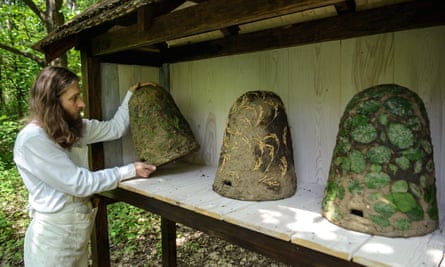
The archaeological evidence for bee keeping, not just wild honey collecting, is sparse, but what does exist is geographically broad. Bees were a common symbol in the Ancient World, with the practice of bee keeping seeming to be an important aspect to the neolithic revolution and the emergent dependence on agriculture. For instance the honey bee held a special place in Ancient Egyptian mythology, being born from the tears of the Sun God Ra. Bees are a hieroglyph that occurs as parts of titles of state, and depictions of horizontal hives decorate some tomb walls.
Early direct archaeological evidence is from Israel, in the ancient city of Tel Rehov (Tell es-Saram in Arabic) dating to the tenth-to-ninth centuries BCE. While many bee hives are often outside of cities, this site recorded 30 hives, with an estimated total of 100 hives at the time of use, within a dense urban area. This discovery was striking for a couple of reasons. Not only does it speak to the prominent role of honey and and other bee products in ancient economies, but keeping up to 100 hives in an urban area speaks to the possible ecology of the city and the wide availability of food for the hives.
Many excavated hives like those at Tel Rehov, or depicted such as in Ancient Egyptian art works, are of cylindrical, horizontal hives, often built into walls and made of fired clay or ceramic. This was not necessarily universal, however. Archaeological evidence has indicated that in Greece upright clay pots were used for bee hives. As of 2012 the archaeologists working on bee hives in Greece reported that no lids or lid fragments had been recovered for these vessels. Experimental archaeology re-creating these clay-pot hives, and using both clay lids and wooden bars or strips, and using these clay hives to actually to rear bees proved that ancient apiarists could have utilized movable combs, meaning they could remove portions of the bee hive and transfer them to other vessels, much like the movable frames in modern box hives today. To many it is an esoteric point, but modern bee keepers see the Langstrom hive, or the stack of boxes we recognize today in country fields, as the technological advancement that allowed for movable hives. For that to have occurred thousands of years prior to the modern hive is extraordinary to many.
In medieval and pre-modern Europe hives were often kept in boles, or wall recesses that housed wicker and mud skeps that served as the hive. These have been especially well recorded in England, Ireland, and France but are found throughout Europe. These types of operations were associated with gardens or agricultural fields, such as vineyards.

Along with clay and basket skeps, cultures all over the world utilised natural vessels for hives. While the honey bee is an “old world” insect, there were stingless bees, Apis Meliponinae, that were kept for honey by the Ancient Maya in the New World, usually in logs that were closed by ground-stone discs. Interestingly, when these discs were first identified by archaeologists in the 1970s, they were found in pairs of the same size, separated by short distances. These pairs differed in diameter from other pairs of stone discs, and are thought to have been made to the same diameter as the opening of the log. Ethnographically these types of log hives are seen stacked in “A” frames and were described by 16th-century Spanish explorers to the region. The Maya also had a Bee God, Ah Mucan Cab. Mayan bee keepers, like bee keepers in many other cultures, created a fermented drink, Balche, made from the honey of the stingless bee and tree bark. This was reportedly widely used on ceremonial occasions related to the life cycle of keeping the bees and the harvest of the honey and wax.

These types of vignettes, while almost illusory, add a bit of dimension to our understanding of the prehistoric, ancient, and pre-modern world. Activities such as bee keeping were undertaken by a minority of people then, as today, but help to remind us if the richness of human activity. Beyond the functional aspects of honey and wax, entire monographs could be written on the various cultural meanings and symbols surrounding bees, and indeed have been- the bible of bees across cultures is Eva Crane’s 1999 tome “The World History of Bee Keeping and Honey Hunting,” which includes a wealth of archaeological information. The 2015 monograph “The Tears of Re” by Gene Kritsky is a cultural and economic history of bees in Ancient Egypt.
Bees remain important in our contemporary lives. A 2014 study of urban bee keepers in Brooklyn by Moore and Kosut illustrated that bee keeping in the United States was an essential practice for a certain demographic of people looking to have some control over an increasingly fraught climate. The ability to practice a sustainable hobby allows people to participate in a new way of living in a crowded world, a way of living that simultaneously harkens back to old ways of living. I’m personally reminded that I may fall within that demographic. While I am neither an expert apaiarist nor an expert on the archaeology of apaiaries, I find it comforting that this is an activity that is part of a universal human experience. Most of us no longer worship any given bee god, but many of us still see the return of pollinators to our little patches of earth as a sign of spring and a yearly renewal. Another interesting aspect of the Moore and Kosut article is that the authors are also engaging in an emerging field of anthropology, “intra-species” or “critical animal” studies, where the animals themselves are informants alongside their human counterparts. With the impact that honey producing bees have had on human cultures across the globe for thousands of years, I would argue that they probably have a lot to tell us.
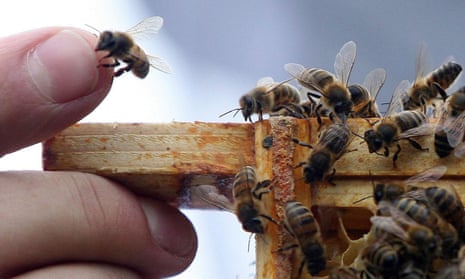



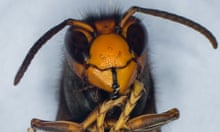

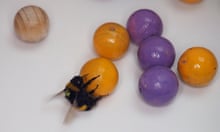

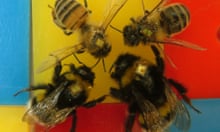
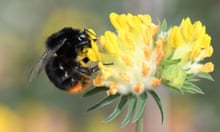
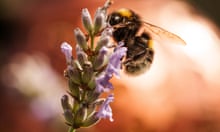
Comments (…)
Sign in or create your Guardian account to join the discussion